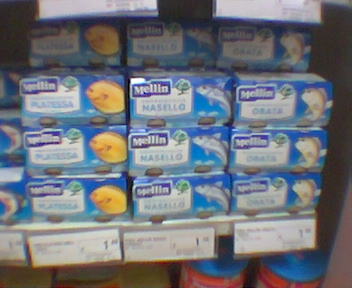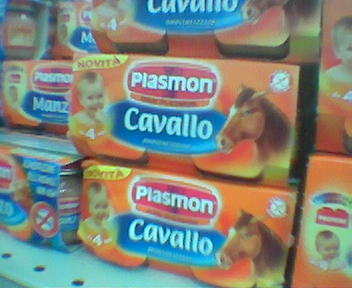Now, I've already written about Italian foods that may be appetizing even to non-Italians. But not all of them are... "What has this mutual disgust at each other's eating habit got to do with culture?" writes John Monaghan and Peter Just in Social and Cultural Anthropology: A Very Short Introduction. Everything! "For one thing... distinctions between 'food' and 'not food'... have to do with more than simple questions of edibility.... This kind of categorization is part of the work of culture, and is something that we do not only with regard to food, but in every other imaginable domain.... The specific content of the categorizies may differ, but the fact of classification remains constant." Now, I could itemize one-by-one Italian foods that most Americans wouldn't generally consider "edible," but I'd risk belittling Italian tastes and making Americans' seem like the be all and end all. Instead, I'd want to try to get a handle on the different systems of categorization.
This week, I had an idea about exactly how to start. Where would we see the greatest distinctions between foods we'd consider "edible" and "non-edible," or "healthy" and "unhealthy," than what we feed babies? And sure enough, a quick glance in the Italian "ipermercato" (Italian for a mega supermarket) is enough to show you that not even baby food is universal!
(Compare the offerings with the American ones of Gerber, and you'll see what I mean...)
Let's start off easy. Both have strained veggies and fruit. But the Italians also offer kinds like strained zucchini and pureed chickpeas. (The after-effects of the latter, though, kind of like Gerber's "Latin Recipe" red beans and rice, I sort of wonder about...) Then, of course, instead of cereals, we've got baby pasta and extra-vitamin-fortified extra-virgin olive oil.

No "meals" like Gerber's mac and cheese, though. Nope, for growing Italian babies, you get into the meat and fish course. That's right, fish. Now, I'm not entirely certain why Americans don't have pureed fish (except that it might just seem too much like the old SNL "bassomatic"), but Italians have a variety: mixed fish, cod, hake, salmon, flounder, and--of course--sea bass.
 But we're not at the pièces de résistance yet!
But we're not at the pièces de résistance yet!First of all, we've got the freeze-dried rabbit (in the handy resealable confection that lets you rehydrate just a bit o' rabbit at a time...)
And last, but certainly not least, we have the pureed horse.
 That's right, horse!
That's right, horse!Now, before we get too upset... we're not talking pureed Trigger or my friend Flicka here. These are not glue-factory rejects, but horses raised expressly for their meat, which Italians believe to be one of the healthiest kinds available! So, not only do Italians not have a thing about pureed fish, they also don't have the "if Disney's made a movie about it, don't eat it" problem.
Of course, we're not talking about "Pets or Food?" as in this joke website. But regarding the categories of what a culture eats, well, we could be "symbolic" or "functionalist" about this. Functionalist is probably easier; for example, it might be interesting to see if both cultures could agree on which babies are healthier...
In the meantime, I wonder if Italians play the airplane game.
Categories: Italy, Food, Humor
No comments:
Post a Comment